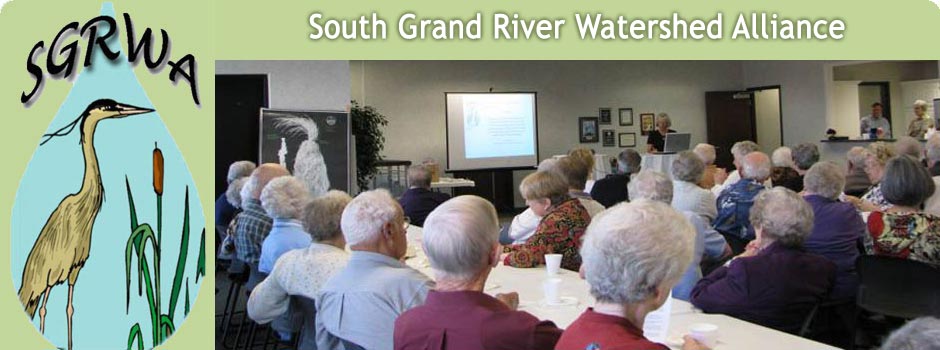Check your watershed knowledge with this quiz. For help and for information about the South Grand River Watershed Alliance, check www.sgrwa.org. Answers to this quiz are at the bottom of the page.
1.) “The area of land that catches rain and snow and drains or seeps into a marsh, stream, river, lake or ground water” is the definition of:
a. river
b. lake
c. watershed
d. aquifer
2.) Which of the following are functions of a rain garden that contribute to better water quality?
a. they are pretty
b. they absorb 30% more rainwater than a comparable area of lawn.
c. the native plants recommended for rain gardens help the rainfall to be absorbed where it falls rather than being channeled into a stormwater drain.
d. rain gardens help filter out pollutants.
3.) Which of the following are not true of stormwater runoff?
a. as it washes across impervious surfaces, stormwater carries oil, herbicides, pesticides, heavy metals, pet wastes and other contaminants into the waterways.
b. it contributes to erosion.
c. It causes changes to the chemistry and temperature of a stream.
d. It goes to a treatment plant before it is discharged into a waterway.
e. It is discharged directly into waterways without going through a treatment facility.
4. Which of the following does not contribute to the restoration and protection of our waters?
a. a riparian zone of natural vegetation along each side of a stream
b. a diversity of native plants and animal species in the riparian corridor
c. mowed and well manicured turf up to the edge of the stream
d. “straightening” the stream to speed up the runoff
e. allowing a stream room to naturally meander.
5. Which of the following is not true of ephemeral streams?
a. they are so small they are insignificant to the health of the waters in the watershed
b. they are very small drainages that may not have water in them much of the year
c. they make up at least 75% of the drainage system of the watershed
d. they are highly significant and contribute greatly to the health of the entire watershed.
6.) It is essential that we protect, restore and conserve our water resource because:
a. even though 75% of the earth’s surface is covered with water, only three tenths of a percent is readily available for humans and other species that depend on it
b. with an increasing human population demands for this limited resource are growing
c. it is the responsible thing to do
7.) Actions individuals can take as responsible stewards of our water resource are:
a. reduce or eliminate the use of chemicals on lawns
b. use native plants in landscaping
c. be an advocate for protecting and restoring our waterways
d. use our water resource wisely by conserving
e. use a rain garden/s in landscaping
f. install rain barrels
g. pick up your pet’s wastes and dispose of properly
8.) Water quality can be protected with Low Impact Development. Which of the following is not a characteristic of LID?
a. narrow streets
b. clustered houses
c. large areas of open space with natural vegetation
d. mowed and manicured open space
e. rain gardens
f. grassy swales along streets
9.) True or False—the greatest threat to water quality is human activities.
10.) True of False—Agricultural practices that leave a buffer area of natural vegetation along streams significantly reduce contamination of waterways.
Answers:
(1.) c,( 2.) b, c, d, (3.) d, (4.) c, d, (5.) a, (6.) a, b, c, (7.) a, b, c, d, e, f, g, (8.) d, (9.) T, (10.) T
